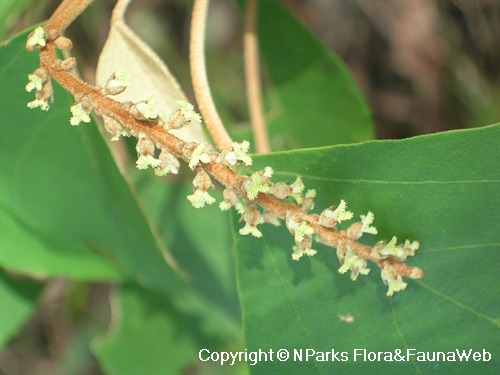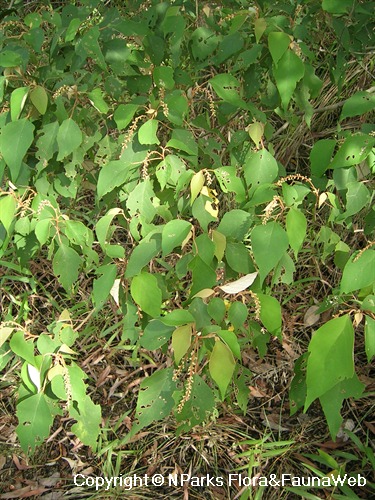
Back
Mallotus paniculatus (Lam.) Müll.Arg.
| Family Name: | Euphorbiaceae |
| Common Name: | Turn-in-the-wind, Balik Angin, Balik Adap, Balik Angin Bukit, Balik Angin Gajah, 白楸 |
Name
Classifications and Characteristics
| Plant Division | Angiosperms (Flowering Seed Plants) (Dicotyledon) |
|---|---|
| Plant Growth Form | Tree, Shrub |
| Lifespan (in Singapore) | Perennial |
| Mode of Nutrition | Autotrophic |
| Plant Shape | Irregular |
| Maximum Height | 25 m |
Biogeography
| Native Distribution | India, Bangladesh, China, Taiwan, Myanmar, Vietnam, Laos, Thailand, Cambodia, Malaysia, Singapore, Indonesia, the Philippines, Papua New Guinea, and northeast Australia |
|---|---|
| Native Habitat | Terrestrial (Secondary Rainforest, Riverine, Disturbed Area / Open Ground) |
| Preferred Climate Zone | Tropical, Sub-Tropical / Monsoonal |
| Local Conservation Status | Native to Singapore (Least Concern (LC)) |
Description and Ethnobotany
| Growth Form | It is a shrub or tree that can grow up to 25 m tall. |
|---|---|
| Foliage | Its alternate leaves have stalks that are sometimes attached somewhat near to the centre of the underside of the leaf blades. Its thick papery leaf blades are diamond-shaped, egg-shaped or triangular-egg-shaped, slightly toothed along the margins, 1–3 lobed, green above, white to pale brown and slightly hairy below, and 3.6–20 by 2.5–17 cm. The connection between the leaf stalk and leaf blade is not very rigid, so enabling the leaf blade to rotate about the point of attachment easily, as when blown by the wind. |
| Flowers | The plant produces unisexual flowers that develop in flowering shoots (inflorescences) at the tip of branches. Its male inflorescences are up to 57 cm long. Its male flowers are yellow, and 4–6.4 mm wide. Its female inflorescences are slightly hairy, and up to 38 cm long. Its female flowers are yellow and are 2–4 mm wide. |
| Fruit | Its fruits are capsules, greenish-brown to greyish-tan, hairy, 5.5–6 by 4.2–12 mm, covered with 10–20 spines that are about 4 mm long, and each has 3 compartments within. Its seeds are partially round, glossy black, and about 2.4–4 mm across. |
| Habitat | It usually grows in secondary forests, clearings, open habitats, forest edges, and along roadsides, up to 1500 m altitude. |
| Associated Fauna | It is the preferred local food plant for the caterpillars of the butterflies, the Malayan (Megisba malaya sikkima), and Yellow Flat (Mooreana trichoneura trichoneura). Its fruits are eaten by birds. |
| Cultivation | It can be propagated by seed. |
| Etymology | Greek Mallotus, woolly, referring to the hairy leaves and fruits in some species; Latin paniculatus, with flowers arranged in a panicle (branched flower cluster) |
| Ethnobotanical Uses | Medicinal: The plant can be made into a decoction to cleanse wounds. The root is given to mothers after childbirth and infants with fever, and can treat headaches. Timber & Products: The timber is used to make matchsticks, packing-cases, rough-work, and used as fuel. The bark can be used for making food containers. |
Landscaping Features
| Landscaping | This usually small tree or shrub may be able to tolerate park or roadside conditions. The leaf blades that swivel in the wind that reveal the dark green upper sides and white or pale brown undersides when blowing in the wind. This species occurrence in open conditions along forest edges along roadsides suggests that it can tolerate the bright conditions of roadsides and parks. |
|---|---|
| Desirable Plant Features | Ornamental Foliage |
| Landscape Uses | General, Suitable for Roadsides, Parks & Gardens, Small Gardens |
Fauna, Pollination and Dispersal
| Fauna Pollination Dispersal Associated Fauna | Bird-Attracting, Butterfly Host Plant (Leaves, Associated with: Megisba malaya) |
|---|---|
| Pollination Method(s) | Biotic (Fauna) |
| Seed or Spore Dispersal | Biotic (Fauna) |
Plant Care and Propagation
| Light Preference | Full Sun |
|---|---|
| Water Preference | Moderate Water, Little Water |
| Plant Growth Rate | Moderate |
| Rootzone Tolerance | Drought Tolerant, Moist Soils, Well-Drained Soils, Fertile Loamy Soils |
| Propagation Method | Seed |
Foliar
| Foliage Retention | Evergreen |
|---|---|
| Mature Foliage Colour(s) | Green, Brown |
| Mature Foliage Texture(s) | Papery, Thick |
| Foliar Type | Simple / Unifoliate |
| Foliar Arrangement Along Stem | Alternate |
| Foliar Attachment to Stem | Petiolate |
| Foliar Shape(s) | Non-Palm Foliage (Ovate, Deltoid) |
| Foliar Venation | Pinnate / Net |
| Foliar Margin | Serrate / Toothed |
| Leaf Area Index (LAI) for Green Plot Ratio | 3.0 (Tree - Intermediate Canopy) |
Floral (Angiosperm)
| Flower & Plant Sexuality | Unisexual Flowers, Dioecious |
| Flower Colour(s) | Yellow / Golden |
|---|
| Flower Grouping | Cluster / Inflorescence |
| Flower Location | Terminal |
Fruit, Seed and Spore
| Mature Fruit Colour(s) | Brown, Green |
|---|---|
| Mature Fruit Texture(s) | Thorny / Spiny |
| Fruit Classification | Simple Fruit |
| Fruit Type |
Image Repository
Others
| Master ID | 1716 |
|---|---|
| Species ID | 3009 |
| Flora Disclaimer | The information in this website has been compiled from reliable sources, such as reference works on medicinal plants. It is not a substitute for medical advice or treatment and NParks does not purport to provide any medical advice. Readers should always consult his/her physician before using or consuming a plant for medicinal purposes. |

